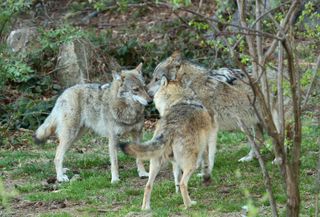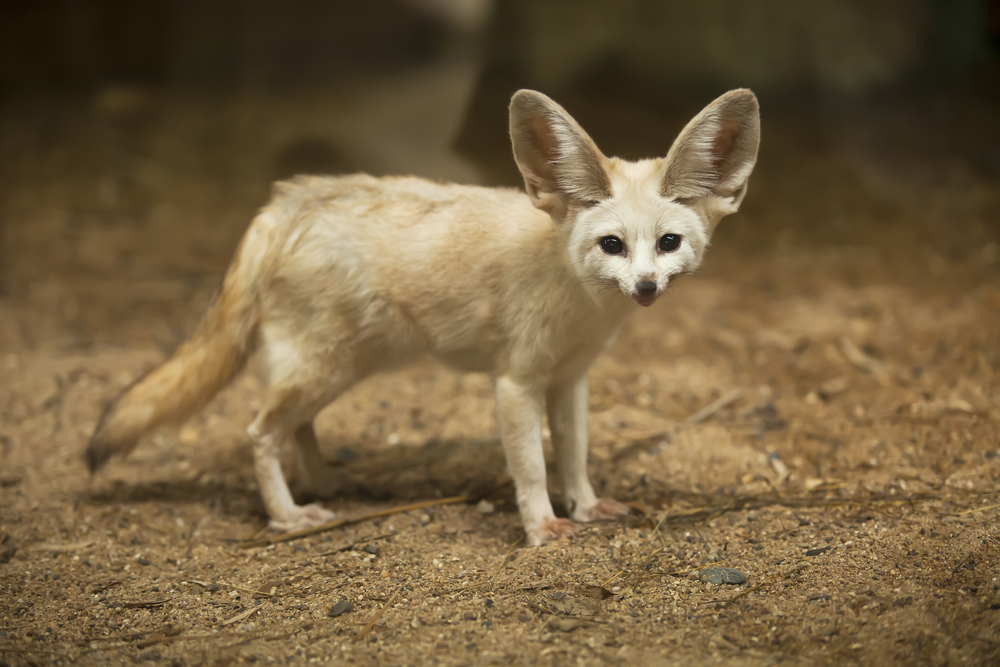Which Animal Is Related To Wolves Are Both Wolves And Foxes Carnivores
Dog Family: Facts Well-nigh Canines & Their Cousins

Dogs and humans have been all-time friends for thousands of years. Researchers know that dogs regularly lived with humans by most ten,000 years ago, and dogs and people are found buried together every bit early as 14,000 years ago. And for fifty-fifty longer, perchance hundreds of thousands of years, humans walked alongside the canis familiaris's antecedent, an extinct species of wolf.
Domestic dogs and wolves are role of a big taxonomic family called Canidae, which likewise includes coyotes, foxes and jackals, according to the Integrated Taxonomic Information System (ITIS). Members of this family are called canids. Domestic dogs are a subspecies called Canis lupus familiaris. [Related: How Did Dogs Get to Be Dogs?]
Size
The Canidae family includes xiv genera and 34 species, according to the University of Michigan's Animal Diversity Web. With such diverseness, information technology is easy to run into why in that location are then many different sizes of dogs. Co-ordinate to the University of Edinburgh, the smallest canid is the Fennec fox. Information technology is only 9.4 inches (24 centimeters) high and weighs only two.2 lbs. (1 kilogram). The largest canid is the gray wolf, at 6.5 feet (200 cm) high and 3 to 5 feet (1 to 1.v meters) long. Their tails add an additional 1 to two feet. Females typically counterbalance 60 to 100 lbs., and males weigh 70 to 145 lbs., according to the National Wild fauna Federation.
Habitat
Canids are establish all over the world. Coyotes roam North America's forests and mountains. Red foxes live in grasslands, forests, mountains and deserts in the Northern Hemisphere, according to National Geographic (opens in new tab). Jackals are establish in the savannas, deserts, and arid grasslands of Africa. Wolves live on every continent in the Northern Hemisphere.
Habits
Canids are typically social and travel in groups called packs. They are very territorial, though, and marking their territory with scent marking. Even domesticated dogs volition mark their yards by leaving their scent on trees, bushes and objects.
Jackals are a little less social and usually travel in pairs, according to the African Wildlife Foundation. Males and females mate for life, which is very rare for mammals.
Wolves, foxes and other dogs don't howl at the moon. They are actually howling at each other as a form of advice. Dogs also yelp, whine, bark and growl to communicate.
It is a myth that domesticated dogs only meet black and white. They are actually red-green colorblind, according to a small 2017 Italian study on 16 dogs. "If you are planning to train your canis familiaris to fetch a ball that brutal on the green grass of your garden, think of using a bluish, and not cherry-red, ball," said study lead researcher Marcello Siniscalchi, a professor in the department of veterinary medicine at the University of Bari, in Italy. This is most likely due to the fact that dogs accept evolved from creatures that hunted during dusk and dawn, which doesn't crave colour vision. [Doggone: Your Best Friend Is Red-Green Colorblind]
Domestic dogs are too very expressive in their facial expressions, particularly when they are getting attention from humans, co-ordinate to a 2017 written report published in the journal Scientific Reports (opens in new tab).
"The findings appear to support evidence [that] dogs are sensitive to humans' attention and that [their] expressions are potentially active attempts to communicate, not unproblematic emotional displays," lead written report author Juliane Kaminski, a senior lecturer in psychology and leader of the Domestic dog Knowledge Centre at the Academy of Portsmouth in England, said in a statement. "Domestic dogs have a unique history — they take lived alongside humans for xxx,000 years, and during that time, selection pressures seem to have acted on dogs' ability to communicate with united states."
Diet
Though dogs are omnivores, they eat mostly meat and are born killers. They have non-retractable claws, long legs for speed and teeth that are sharp, pointed and perfect for tearing at meat. Wolves, for example, consume deer, domestic livestock, caribou, beaver, moose and hares. Jackals eat smaller fare such as rodents, young gazelle, rabbits and monkeys.
Dogs also have well-developed carnassial molars, upper and lower teeth that are paired and have flat edges that let self-sharpening when they pass by each other. Co-ordinate to the Academy of Illinois at Urbana-Champaign, these teeth are used to crush vegetation such every bit fruits and grasses.
Offspring
All members of the Canidae family take live births after a gestation menstruation of 45 to 55 days. Canids typically take many babies at in one case. Domestic dogs can accept as many as 15 young, chosen pups, at the same time. Other genus types are less prolific. For example, greyness foxes (genus Urocyon) have just ane to seven young per year, according to the University of Illinois at Urbana-Champaign. The Biological Sciences Department of Smith College reports that at that place is a correlation between the weight of a canid and reproduction; the larger the female, the larger the litter size.

Classification/Taxonomy
The taxonomy of dogs, according to ITIS, is:
Kingdom: Animalia Subkingdom: Bilateria Infrakingdom: Deuterostomia Phylum: Chordata Subphylum: Vertebrata Infraphylum: Gnathostomata Superclass: Tetrapoda Class: Mammalia Bracket: Theria Infraclass: Eutheria Order: Carnivora Suborder: Caniformia Family: Canidae Genera & species:
- Atelocynus microtis — curt-eared dog, small-eared dog, small-scale-eared zorro
- Canis adustus — side-striped jackal
- Canis aureus — aureate jackal
- Canis latrans — coyote
- Canis lupus — wolf, grayness wolf (Subspecies: Canis lupus familiaris — domestic domestic dog)
- Canis mesomelas — black-backed jackal
- Canis simensis — simian jackal, simian fox, Ethiopian wolf
- Cerdocyon thous — crab-eating fob
- Chrysocyon brachyurus — maned wolf Cuon alpinus — dhole, Indian dhole, Asiatic wild dog, red dog
- Dusicyon australis — Falkland Island wolf, Falkland Islands wolf
- Lycalopex culpaeus — culpeo
- Lycalopex fulvipes — Darwin's flim-flam
- Lycalopex griseus — Due south American grayness fox
- Lycalopex gymnocercus — pampas fox
- Lycalopex sechurae — Sechuran play a trick on
- Lycalopex vetulus — hoary fox
- Lycaon pictus — African hunting canis familiaris, African wild domestic dog
- Nyctereutes procyonoides — raccoon dog
- Otocyon megalotis — bat-eared fox, big-eared play a trick on
- Speothos venaticus — bush domestic dog
- Urocyon cinereoargenteus — gray fox, common gray fox
- Urocyon littoralis — isle fox, isle gray play a joke on, Channel Islands gray play tricks
- Vulpes bengalensis — bengal fox
- Vulpes cana — Blanford'southward fob
- Vulpes chama — greatcoat fob
- Vulpes corsac — corsac fox
- Vulpes ferrilata — Tibetan pull a fast one on, Tibetan sand play tricks
- Vulpes lagopus — blue trick, ice flim-flam, polar fox, white fox, Arctic fox
- Vulpes macrotis — kit pull a fast one on
- Vulpes pallida — pale fox
- Vulpes rueppellii — Rüppell'south play a trick on
- Vulpes velox — swift fox
- Vulpes vulpes — cerise fox
- Vulpes zerda — fennec, fennec fox
Conservation status
The International Marriage for Conservation of Nature (IUCN) has many dogs on its Red List of Threatened Species.
Near threatened (by and large due to small geographical range and habitat loss) are the short-eared dog (Atelocynus microtis), maned wolf (Chrysocyon brachyurus), Sechuran fox (Lycalopex sechurae), island fox (Urocyon littoralis) and bush dog (Speothos venaticus).
Darwin's fob (Lycalopex fulvipes) — with a population of 659 to 2,499 mature individuals; the African wild domestic dog (Lycaon pictus) — only 1,400 mature individuals; the dhole(Cuon alpinus) — 949 to ii,215 mature individuals; and the Ethiopian wolf (Canis simensis) — but 197 mature individuals — are endangered.
The cerise wolf (Canis rufus) is critically endangered. The species was extinct in the wild past 1980, and only exists now in a reintroduced population in eastern North Carolina. The total population is less than 150 individuals — and no more than than 50 are mature.
The Falklands wolf (Dusicyon australis) has been extinct since 1876.
Other facts
The life span of a domestic dog varies, depending on what type it is. Wolves, coyotes, jackals and domestic dogs live 10 years or more. Vulpes, or truthful foxes, alive around five years.
Coyotes are scavengers that will eat almost anything. Their nutrition includes bugs, trash, deer, rodents and snakes. They are too very fast runners and can stitch to 40 mph (64 km/h), according to National Geographic (opens in new tab).
The lead male and female person are the only two that typically breed in a wolf pack. Their bureaucracy is very strict. A pack is normally pb past a dominant male.
Dogs can go the flu. [Coughing Canines? 6 Things to Know About Dog Flu]
Boosted resources
- Encyclopedia of Life: Canidae
- University of Illinois at Urbana–Champaign: Family Canidae
- African Wildlife Federation: African Wild Dogs
Source: https://www.livescience.com/50471-dog-family-facts-about-canines-their-cousins.html
Posted by: richmondeliand.blogspot.com

0 Response to "Which Animal Is Related To Wolves Are Both Wolves And Foxes Carnivores"
Post a Comment